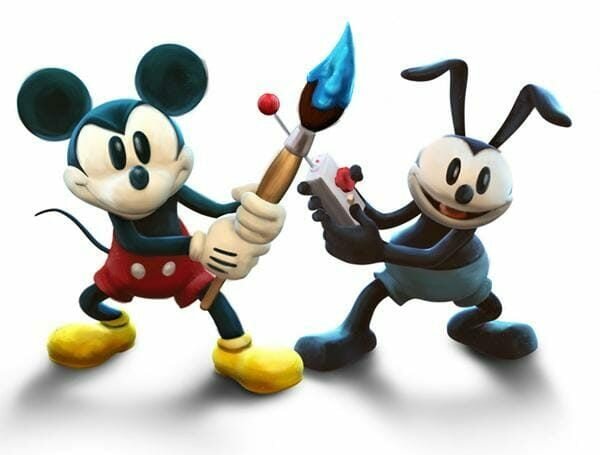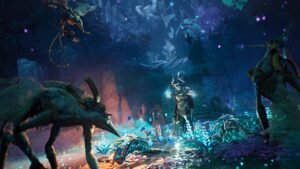ToonsIn Trouble Again
You have to give credit where it’s due, Warren Spector is a man of vision and originality. Epic Mickey was, on the surface, a pretty whacky idea. And yet somehow, he managed to get the official blessing (and license) of the Disney company to take their most cherished characters and put them through a surprisingly dark story about the vendetta of Walt Disney’s forgotten, early character Oswald. At that time, the game’s not so stellar sales might have been blamed on the fact that it was a Wii exclusive when Wiis were already being relegated to closets and only dragged out for Wii Sports sessions with visitors. This time, Epic Mickey 2 is on every viable hardware platform available. But that still doesn’t push it into the top tier of great games.
Paint & Thinner
 The chief problem with Epic Mickey 2 is that it doesn’t really seem to know who the audience is. Is it kids that just want a fluffy, easy adventure full of color and movement? Is it platform fans looking for new mechanics to add spice to their exploration? Maybe RPG fans that want sidequests? It tries to be all of these things, but doesn’t succeed particularly well at any of them.
The chief problem with Epic Mickey 2 is that it doesn’t really seem to know who the audience is. Is it kids that just want a fluffy, easy adventure full of color and movement? Is it platform fans looking for new mechanics to add spice to their exploration? Maybe RPG fans that want sidequests? It tries to be all of these things, but doesn’t succeed particularly well at any of them.
Epic Mickey 2 is about the co-op team-up between Mickey Mouse and the villain of the first game, Oswald. Now a dirty pair, they investigate a series earthquakes and sabotage attempts at the urging of the also reformed Mad Doctor from the first game. The plot thickens from there in the usual Disney manner with songs and hijinks. Unfortunately, like the rest of the game, there’s a distinct schism between the 2D cut scenes and their more straightforward mystery tale, versus the more elaborate in-game plot of quests and investigations that smack of contrivance for the sake of pushing the story forward.
The basic mechanics of the game are two-fold. One is the “paint and thinner” concept from the original, which has Mickey choosing between using green thinner to disintegrate objects in the environment for traversal or puzzle solving purposes, or blue paint to restore things for similar reasons. The other new concept is the co-op system between Mickey and Oswald. This is where one of the big problems of the game lies for single players. The game is fundamentally skewed towards local, co-op play, and the single player experience can suffer as a result. Many puzzles are geared towards requiring the use of both Mickey and Oswald’s abilities, but in the single player game, you are forced to use Mickey alone and rely on the AI of Oswald—and his suite of electric/hacking abilities—to complete certain objectives. This often results in waiting around for the AI to get into position to help you out, something it frequently fails to recognize.

This is symptomatic of the rest of the game’s elements which always feel at war with each other. Like an RPG there are numerous sidequests. Like a platformer or Zelda style game, there are numerous collectibles, but these things lack the “organic” natural feeling of properly coexisting together, the way they do in games like Okami. The game’s paint and thinner mechanics for restoring and disintegrating are supposed to encourage exploration and experimentation but feel limited in use. The collect-a-thons feel contrived and the rationales for undergoing them lack the inspiration or motivation they do in other games, feeling like the “busy-work” other games manage to disguise. The child-like graphics and premise are overwhelmed by some tedious boss fights that would be tolerable in a typical hardcore game, but are probably too off putting for younger audiences that will lack the skill or patience of an older gamer. And finally, the controls—which are strictly traditional in the Xbox 360 version—never settle into a comfortable configuration between either “regular” control or the optional motion controls provided by the Wii/Move versions. Like Okami, using the paint/thinner systems with motion controls makes shooting easier, but hampers navigation, especially when it comes to jumping and combat. Unlike Okami, switching back to regular controls has a significant impact on your efficiency with the thinner/paint elements.Even the geography—which is once again divided by side-scrolling sections based on old Disney shorts—feels distinct and disconnected, never parts of an entire world that fit all together. What is impressive is the amount of love and knowledge the game shows for Disney’s properties. If you know the lore of Disney inside out, you’ll appreciate the thoroughness of their research.
In the end, Epic Mickey: The Power of Two is a game that needed more polishing. None of its elements are fundamentally broken, but they don’t form a cohesive, compelling whole that inspires you to play. It’s not a terrible game, but in a year when experiences like Journey and the The Walking Dead are available for less than $30, asking for $60 for a game that never really comes together and has moments of fun that come in spurts is just not realistic.





